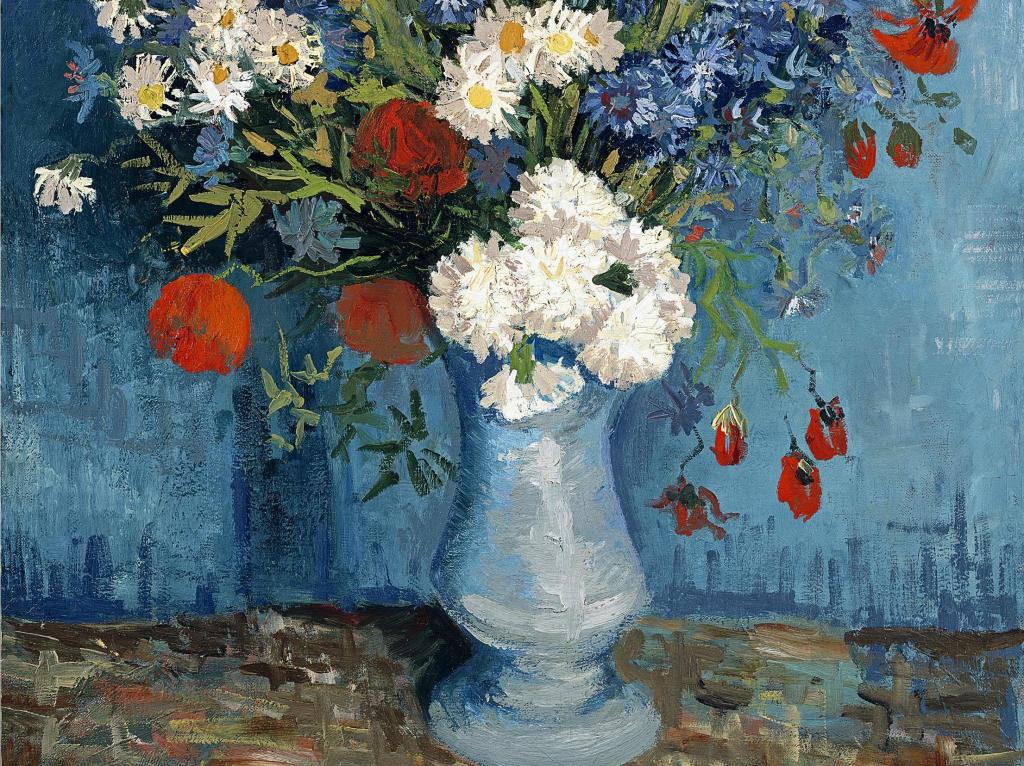Image: Vincent van Gogh Dutch 1853–1890 Still life with wildflowers and carnations summer 1887 Paris oil on canvas 80.0 x 67.0 cm Private Collection.
Imagine this. A lone figure, bandage wrapped around his head, grimacing under the weight of an easel, canvas and paints that he carries on his back as he trudges towards a waving field of golden wheat or stands under a swirling starlit night sky. He sets up and with a manic energy paints, capturing the scene unfolding before him in fiery brush strokes and vivid colour. Stories of an argument and a severed ear are carried on the breeze of gossip, forever branding him the troubled genius. But what do we really know of the work and life of Vincent van Gogh?
Van Gogh and the Seasons presently showing at the National Gallery of Victoria (NGV) as part of the Melbourne Winter Masterpieces series 2017 presents a different insight into the man and his art. Well researched and sensitively curated by Siraar Van Heugten (independent art historian and former Head of Collections at the Van Gogh Museum, Amsterdam) the exhibition introduces the viewer to some of the important motivations and inspirations behind Van Gogh’s art as well as some known and lesser known works.

Vincent van Gogh Dutch 1853–90 Avenue of poplars in autumn late October 1884 Nuenen oil on canvas on wood panel 99.0 x 65.7 cm Van Gogh Museum, Amsterdam Purchased with support from the Vincent van Gogh Foundation and the Rembrandt Association (s0141M1977) .
A deeply religious man, Van Gogh initially tried his hand as an art dealer and travelling missionary before becoming an artist. Through the cycle of the four seasons, a symbol for birth, maturation and death, he explored his love of the natural world and pursued his search for the god that he believed was everywhere and in all things.
The artist and his deep connection with nature is the focus of the exhibition narrative; a short video presentation in the first space sets the scene before influences and his study of the seasons are explored. A room of Japanese ukiyo-e wood block prints, drawn from the NGV collection and featuring such works as Utagawa Hiroshige’s Seven mile beach, Söshū Province, (1858) and Kitagawa Utamaro’s Chrysanthemum festival, 9th September, (1803) reflect the profound influence that Japanese art played in Van Gogh’s work through his use of colour and exploration of the infinite in everyday day scenes.
Sourced from various international museums including the Van Gogh Museum, Amsterdam and the Kröller-Muller Museum, Otterlo, the works featured are examples from various periods in his short but prolific artistic life (he died at just 37): his early years in the Dutch region of Brabant and later Arles in the south of France – his most creative period – to Saint-Rémy de Provence where he was treated for mental illness at the asylum Saint-Pau-de-Mausole and finally Auyers-sur-Oise, where he died in 1890.
Panel divides or mesh blinds form smaller, intimate spaces for viewing of the artist’s cycle of seasons. Potato digging (Five Figures), (1883), an oil sketch on paper, is an image of peasants working the land, a theme to which he would return regularly throughout his artistic life; his monochromatic choice of colours reflecting his early exploration into colour theory.
Olive grove with two olive pickers, (1889), oil on canvas, is an Autumn scene, Van Gogh’s favourite time of year, and reflects impressionistic and post impressionistic influences in his mark-making and lighter, brighter palette; the flattening of figures and dark outlines reflect the influence of Japanese art. While snow covered fields capture winter and a world asleep, The garden of the asylum at Saint-Rémy, (1889), oil on canvas celebrates spring, a world alive with vivid colour and movement. Works such as Wheatfields, an oil on canvas sketch, (1888) inspired Van Gogh to write in a letter to his friend Émile Bernard ‘yearnings for that infinite of which the Sower, the sheaf, are the symbols, still enchant me as before’ provide an insight into the deeply spiritual experience that infused each work.
Drawing on the prolific correspondence between Van Gogh and his brother Theo, an art dealer and life-long supporter of his art, this thoughtfully presented and curated exhibition is supported by text panels and multimedia displays. Floating quotes that appear on walls and floor throughout the exhibition are taken from this correspondence and reflect his thoughts on art, life and the spiritual. At exhibition end a merchandise section carries Van Gogh’s love of nature into the public domain with, among a range of items, a series of seasonally inspired shoes.
Highly recommended.
Rating: 3 ½ stars out of 5
Van Gogh and the Seasons
NGV International, Melbourne
28 April – 9 July 2017
Open 10am – 5pm daily





